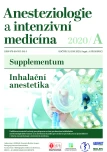-
Medical journals
- Career
Inhalation anesthetics in pediatric anesthesia
Authors: V. Mixa
Authors‘ workplace: Klinika anesteziologie, resuscitace a intenzivní medicíny 2. LF UK a FN Motol
Published in: Anest. intenziv. Med., 31, 2020, č. Supplementum A, s. 22-25
Overview
Inhalation anesthetics have long been an essential part of supplemented and combined anesthesia administered to pediatric patients. Sevoflurane is currently used in most cases, with desflurane and nitrous oxide being used to a lesser extent. Due to its properties, sevoflurane is intended both for smooth inhalation introduction and for anesthesia in all age groups of children, including newborns and premature infants. Supplemented with sufentanil and cisatracurium, or combined with levobupivacaine, it is the basis for safe general anesthesia characterized by circulatory stability and ease of control. Desflurane is not suitable for inhalation as it irritates the respiratory tract. Both sevoflurane and desflurane have low neurotoxicity for a maturing child’s brain. Isoflurane has eliminated the risk of neurotoxicity from pediatric anesthesia.
Emergence from sevoflurane anesthesia is rapid, and is only accompanied by postoperative nausea or vomiting in exceptional cases. Sevoflurane and desflurane do not have an analgesic effect; therefore, postoperative analgesia must be provided after painful procedures. In 25-50% of cases, restlessness and confusion, known as emergence delirium (ED), are observed after inhalation anesthesia. This is probably caused by a rapid emergence from the anesthesia and the inability of a small child to compensate for discomfort. It is more common where no sedative medicine has been used during the anesthesia. This condition may be counteracted by the i.v. application of 1 mg/kg of propofol.
It appears that inhalation of sevoflurane will long be a safe basis for pediatric anesthesia. Neurotoxicity or other complications (e.g. malignant hyperthermia) should never be completely excluded. Therefore, anesthesia should be indicated prudently, its duration minimized, and artificial hypoxia, hypoglycemia, hypotension, hypothermia, and other factors that may compromise the success of the anesthesia of the child should be carefully eliminated.
Keywords:
pediatric anesthesia – inhalation anesthetics – sevoflurane – desflurane – emergence delirium – neurotoxicity of anestetics
Sources
1. Mai ChL, Coté ChJ.: A history of pediatric anesthesia: a tale of pioneers and equipment. Pediatric Anesthesia 2012; 22 : 511-520.
2. Koutecký J.: Vzpomínky na pražskou dětskou anesteziologii 50. let. Anest. intenziv. Med., 2010; 21 (1): 47-49.
3. Li T, Huang Z, Wang X et.al: Role of the GABAAreceptors in the long-term cegnitive impairments caused by neonatal sevoflurane exposure. Rev Neurosci 2019; 30(8), 869-879.
4. Olsen EA, Brambrink AM. Anesthetic neurotoxicity in the newborn and infant. Curr Opin Anethesiol, 2013;26, 535-542.
5. Vutskits L, Xie Z. Lasting impact of general anaesthesia on the brain: mechanism and relevance. Nat Rev Neurosci 2016;18 : 705-717.
6. Brambrink AM, Back SA, Ridle A, et al. Isoflurane-induced apoptosis of oligodendrocytes in the neonatal primate brain. Ann Neurol 2012;72 : 525-235.
7. Sun LS, Li G, Miller TL, et al. Association between a sin gle general anesthesia exposure age 36 month and neurocognitive outcomes in later childhood. JAMA 2016; 315 : 2312-2320.
8. Davidson AJ, Disma N, de Graaff JC, et al. Neurodevelopmental outcoma at 2years of age after general anaesthesia and awake-regional anaesthesia in infancy (GAS): an international multicentre, randomised controled trial. Lancet 2016; 387 : 239-250.
9. Andropoulos DB, Greene MF. Anesthesia and Developing Brains – Implication of FDA Warning. NEJM org. 2016;1-3.
10. Hansen TG. Use of anaesthetics in young children. Eur J Anaesthesiol 2017; 34 : 327-328.
11. Mixa V.: Neurotoxicita anestetik a dozrávající dětský mozek, Anest. intenziv. Med., 2017;28 : 282-286.
12. Mixa V: Dětská anestézie 2016 – jistoty a rizika, Postgraduální medicína 2016; 18 (5):165-469.
13. Veyckemans F.: Excitation fenomena during sevoflurane anaesthesia in children. CurrOpinAnaesthesiol 2001; 14(3): 339-343.
14. Locatelli BG, Ingelmo PM, Emre S et al.: Emergence delirium in Children: a comparison of sevoflurane and desflurane anesthesia using the Paediatric Emergence Delirium scale. Paediatr Anaesth 2013; 23(4): 301-308.
15. Byung GL, Il OL, Hyeongsik A, Dong KL et al. Comparison of the incidence of emergence agitation and emergence times between desflurane and sevoflurane anesthesia in children: A systematic review and meta - -analysis. Medicine (Baltimore). 2016 Sep; 95(38): e4927.
16. Dahmani S, Stany I, Brasher C et al.: Pharmacological preventiv of sevoflurane and desflurane - related emergence agitation in children: a metaanalysis of Publisher studies. Br j Anaesth 2010; 104(2): 216-223.
17. Ramlan AAW , Pardede DKB, Marsaban AH , Hidayat J, Peddyandhari FS. Efficacy of 0.5 mg/kg of propofol at the end of anesthesia to reduce the incidence of emergence agitation in children undergoing general anesthesia with sevoflurane. J Anaesthesiol Clin Pharmacol. Apr-Jun 2020;36(2):177-181.
18. Lauder GR. Total intravenous anesthesia will supercede inhalational anesthesia in pediatric anesthetic practice. Paediatr Anaesth. 2015 Jan;25(1):52-64.
19. Mencía S, Palacios A , García M, Llorente AM, Ordóñez O, Toledo B, López-Herce J. An Exploratory Study of Sevoflurane as an Alternative for Difficult Sedation in Critically Ill Children. Pediatr Crit Care Med. 2018 Jul;19(7):e335-e341.
20. Mixa V. a kol.: Dětská anestézie. 1. vydání, Praha, Mladá fronta, 2019, ISBN 978-80-204-5053-1.
21. Jöhr M.: Inhalation and intravenous anesthesia in pediatric patients. Anaesthesist. 2016; 65(6):415-22.
Labels
Anaesthesiology, Resuscitation and Inten Intensive Care Medicine
Article was published inAnaesthesiology and Intensive Care Medicine

2020 Issue Supplementum A-
All articles in this issue
- Editorial
- Klinická farmakologie inhalačních anestetik – co je nutno znát k atestační zkoušce Oxid dusný
- Sevofluran
- Desfluran
- Inhalational anesthetics in current anesthetic practice
- Inhalation anesthetics in pediatric anesthesia
- How to administer inhaled anesthetics correctly
-
Expertní stanovisko výboru ČSARIM č. 3/2020
ENVIRONMENTÁLNÍ DOPADY INHALAČNÍCH ANESTETIK
- Anaesthesiology and Intensive Care Medicine
- Journal archive
- Current issue
- Online only
- About the journal
Most read in this issue- Inhalational anesthetics in current anesthetic practice
- Sevofluran
- How to administer inhaled anesthetics correctly
- Desfluran
Login#ADS_BOTTOM_SCRIPTS#Forgotten passwordEnter the email address that you registered with. We will send you instructions on how to set a new password.
- Career

